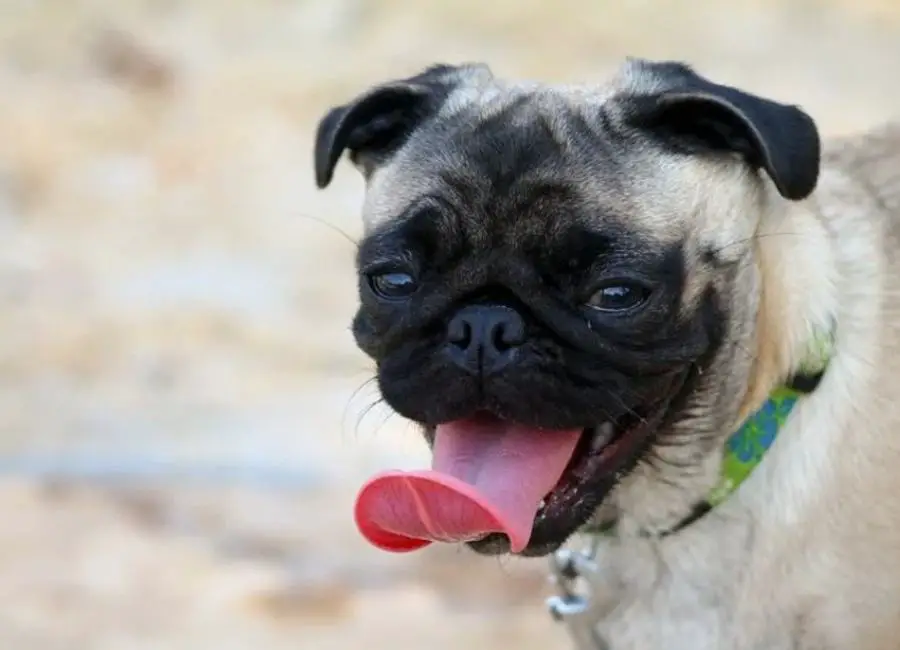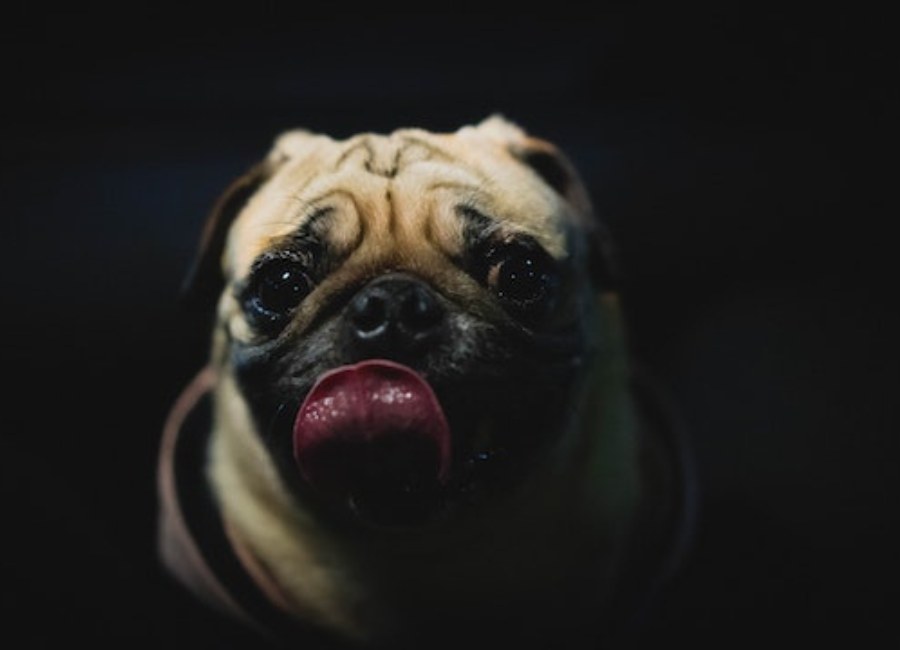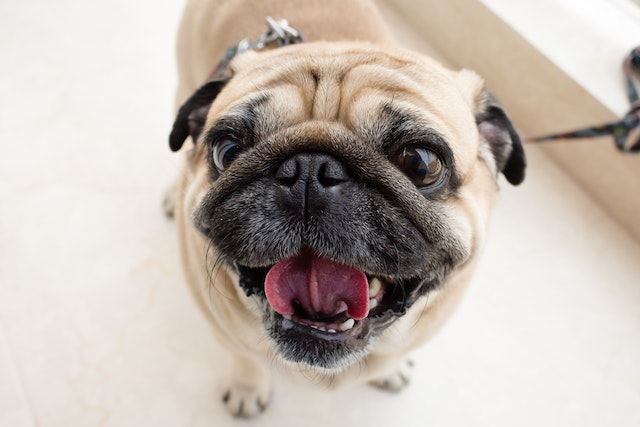10 Reasons For Pug Whining & Control

Pug whining is the sound that a pug makes when it wants something or when they are not ok.
Some owners say that their dogs whine because they’re bored, while others believe it’s an indicator of illness or pain.
While these reasons may seem like good reasons for a dog to whine, there are many other reasons discussed in this post.
Reasons For Pug Whining
The following are some common reasons why pugs might be whining:
1. Physical Discomfort or Pain
Due to their flat faces and short noses, pugs are susceptible to health issues such as respiratory problems, hip dysplasia, and eye issues. Whining could be a sign that your pug is in pain or discomfort.
Watch out for any limping, difficulty breathing, squinting, or changes in appetite. If you notice any of these signs or suspect something is amiss, take your pug to the vet for a thorough examination and appropriate treatment.
2. Anxiety and Fear
Pugs can be sensitive souls, and changes in their environment or routine can trigger anxiety or fear. Common triggers include thunderstorms, fireworks, unfamiliar visitors, or new surroundings.
To ease their anxiety, create a safe and secure space for your pug, like a cozy corner with their bed and toys. Desensitize them to potential triggers by gradually exposing them to these situations and offering positive reinforcement when they remain calm.
3. Loneliness
Pugs thrive on companionship, and being left alone for extended periods can lead to separation anxiety and whining. If your schedule keeps you away from home for long hours, consider hiring a dog sitter or enrolling your pug in a reputable doggy daycare.
Another option is to have a friend or neighbor pop in to spend some time with your pug during the day. Having company will keep your pug content and reduce whining.
4. Boredom
Pugs are intelligent dogs, and they need mental and physical stimulation to stay happy and healthy. When they lack adequate activity or entertainment, they may whine out of sheer boredom.
To combat this, provide your pug with interactive toys, puzzle feeders, and playtime that challenges their minds. Daily walks or outdoor play sessions will also help burn off excess energy and keep them engaged.
5. Attention-seeking Whining

Pugs are social butterflies, and they thrive on human interaction. When they feel neglected or ignored, they may resort to whining to grab your attention.
It’s essential to spend quality time with your pug, offering affection, playtime, and engaging activities. Remember to praise and reward them when they display calm behavior, reinforcing the idea that being quiet and well-behaved earns them positive attention.
Learn more about dog whining while sleeping.
6. Hunger or Thirst
Pugs are little food enthusiasts, and they have a knack for remembering mealtime schedules. Whining might be their way of reminding you that it’s time to eat or that their water bowl needs refilling.
To avoid this, establish a consistent feeding routine, ideally with two or three meals a day. Ensure their water bowl is readily available, especially during hot weather, and keep an eye on their weight to prevent overfeeding.
7. Need to Go Potty
Pugs, like all dogs, have a natural instinct to keep their living spaces clean. Whining might indicate that your pug needs to go outside to relieve themselves.
Create a consistent potty schedule, taking them out in the morning, after meals, before bedtime, and anytime they show signs of needing to go. Reward them with praise and treats when they successfully do their business outside.
Read more: 9 Right Ways To Discipline a Pug.
8. Pug whining can be due to separation anxiety
Separation anxiety is a common condition that affects many dogs, including pugs. Separation anxiety occurs when a dog becomes anxious or distressed when separated from its owner or left alone. This can lead to a range of behaviors, including excessive whining, destructive behavior, and house-soiling, among others.
Pugs, in particular, have a reputation for being highly attached to their owners and may be more prone to separation anxiety. Excessive whining is one of the common signs of separation anxiety in dogs and may occur when the dog is left alone or anticipating being left alone.
To address the issue of separation anxiety in pugs, it is important to start by identifying the underlying cause of the behavior. This may involve working with a trainer or behaviorist to develop a plan that addresses the dog’s anxiety and teaches it to feel comfortable being alone.
Some strategies that may be useful include gradual desensitization to being alone, using calming music or aromatherapy, and providing plenty of mental and physical stimulation to help alleviate anxiety.
Read more: Reasons your pug is barking so much.
9. Environmental Triggers
Pugs have keen senses, and certain environmental stimuli can unsettle them and result in whining. These triggers could include loud noises, unfamiliar objects, or overwhelming crowds.
Identify what sets off your pug and try to minimize their exposure to these situations. Providing a safe and quiet space where they can retreat when feeling overwhelmed will help them feel secure and reduce whining.
10. Attention Reinforcement
Sometimes, unintentionally, we reinforce whining behavior by giving in to our pug’s demands immediately. If your pug whines for treats or attention and you respond promptly, they learn that whining gets them what they want.
Instead, practice patience and wait for your pug to calm down before offering attention or rewards. Reinforce positive behavior and ignore whining to discourage this undesirable habit.
Read more: Pug Behavior Concerns You Should Know.
How to Control Pug Whining

The following are some common ways to control pug whining:
- Identify the Cause: Identify the underlying cause of your Pug’s whining. Some common causes include separation anxiety, fear, hunger, thirst, boredom, and medical issues.
- Establish a Routine: Establish a routine for your Pug, including feeding, playing, and potty breaks. Pugs thrive on routine and knowing what to expect.
- Provide Sufficient Exercise: Make sure your Pug is getting enough exercise to burn off excess energy. This will help reduce anxiety and stress.
- Ignore Whining: Ignore your Pug’s whining unless it is an emergency. Responding to whining can reinforce the behavior and make it worse.
- Reward Quiet Behavior: Reward your Pug for being quiet. Make sure to give treats and praise when your Pug is calm and quiet.
- Crate Training: Crate training can help control whining and teach your Pug to seek out their crate for comfort.
- Behavioral Training: Engage in positive reinforcement training with your pug, teach them to obey simple commands, and always reward them for good behavior.
- Offer Interactive Toys: Interactive toys can provide mental stimulation and keep your Pug entertained.
- Don’t make a big deal out of departures or arrivals: Pugs are highly sensitive dogs and might get anxious when their owners leave or come back home. Ignoring them when you come back and creating a fuss when leaving can worsen the anxiety and increase whining behavior.
- Plan for Company: Plan for company by training your Pug to relax and be calm around guests.
- Consult a Professional: If your Pug’s whining persists or is excessive, consult with a professional dog trainer or veterinarian for more specialized advice.
- Eliminate Hunger or thirst: Ensure that your pug is well-fed and hydrated, hunger and thirst can lead to restlessness and ultimately, whining. If you’re leaving home, provide small amounts of food in puzzle feeders to keep them entertained and occupied in your absence.
Note that not all of these methods will work for every Pug or every situation. It is important to tailor your approach to your individual dog and the underlying cause of their whining.
Read more: Causes of Pug Aggression.
Related Questions
Why do Pugs whine so much?
Pugs are known for their vocal nature, and whining is just one way they communicate with their owners. They may whine when they’re hungry, need to go outside, or are feeling anxious.
Is it normal for Pugs to whine when they’re left alone?
While it’s normal for most dogs to whine when they’re left alone, Pugs may be more vocal than other breeds. This is because they bond strongly with their owners and may become anxious when they’re separated.
Learn more about socializing your pug.
How can I stop my Pug from whining excessively?
It’s important to identify the reason why your Pug is whining and address the underlying cause. If your Pug is whining because they’re hungry, for example, make sure they’re getting enough food. Alternatively, you could try providing them with some toys or treats to keep them occupied.
Learn more about pug growling.
Should I ignore my Pug when they’re whining?
Ignoring your Pug when they’re whining may actually reinforce the behavior, as they may feel neglected. Instead, try to redirect their attention to something else, such as playing with a toy or going for a walk.
Can Pugs whine when they’re in pain?
Yes, Pugs may whine when they’re in pain, so it’s important to monitor their behavior closely and seek veterinary attention if you suspect they’re in discomfort.
Should I be concerned if my Pug suddenly starts whining more than usual?
If your Pug suddenly starts whining more than usual, it may be a sign that something is wrong. They could be experiencing separation anxiety, feeling unwell, or in need of attention. It’s always best to visit your veterinarian to rule out any health issues.
Learn more about pug training tips and temperaments.
Conclusion
In conclusion, the pug is one of the most popular breeds in the world. They are a fun-loving, loyal companion who loves to snuggle with you on cold winter nights.
However, if your dog is whining excessively and crying out in pain or discomfort, it’s time for some vet care. You don’t want to see your pet suffer unnecessarily!
